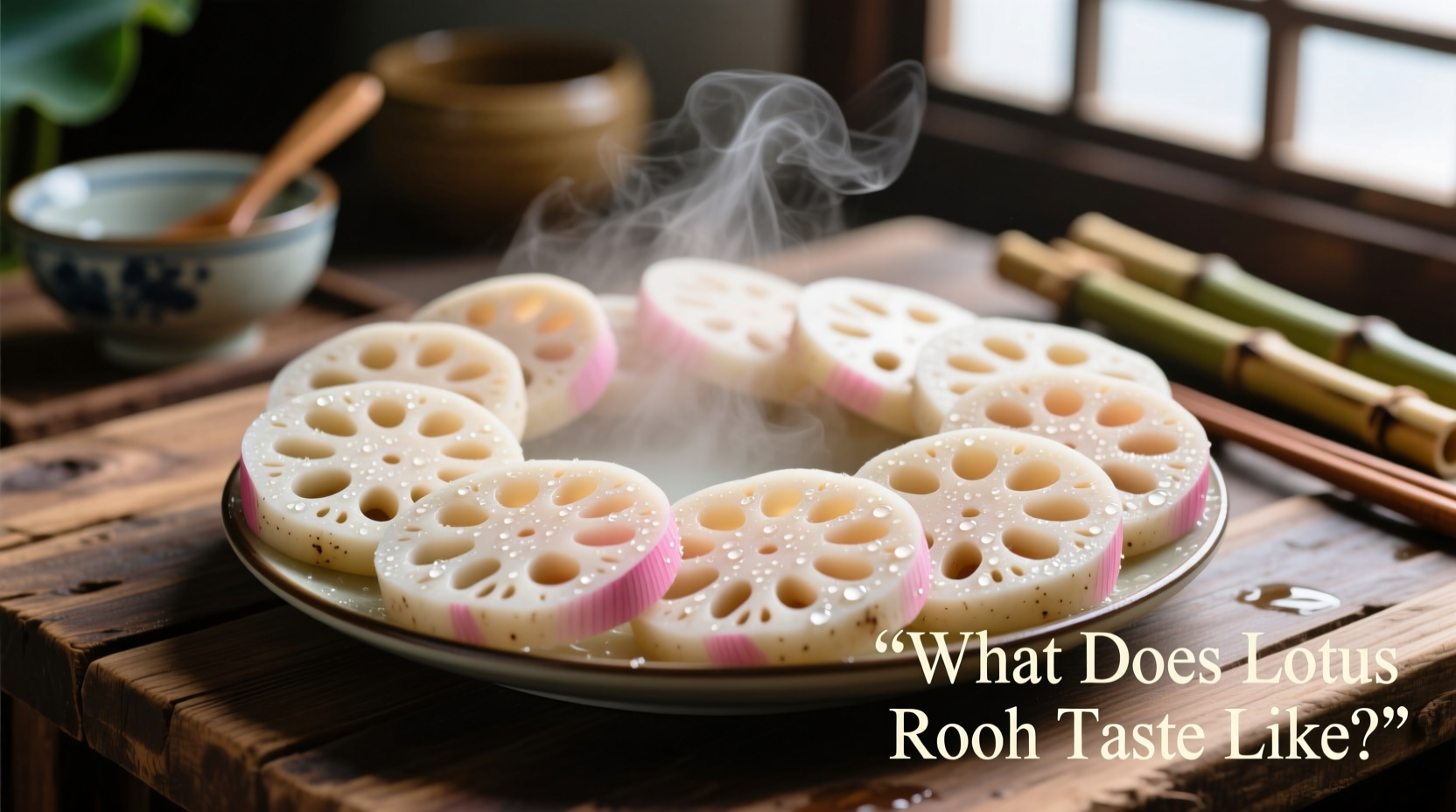Fresh lotus root delivers a mildly sweet, crisp flavor with subtle earthy notes and a refreshing crunch similar to jicama or water chestnut, but with a more delicate, slightly nutty undertone. When cooked, it absorbs surrounding flavors while maintaining a tender-crisp texture that transforms from subtly sweet to savory depending on preparation method.
As a Chinese culinary specialist with decades of experience working with traditional ingredients, I've prepared lotus root in countless regional dishes across China. Understanding its unique flavor profile is essential for unlocking its culinary potential in your kitchen.
Immediate Flavor Profile: What to Expect First
When you bite into raw lotus root, your palate encounters a clean, mildly sweet flavor with delicate earthy undertones. The initial impression resembles a cross between cucumber and radish, but with less peppery bite and more pronounced sweetness. This aquatic vegetable's flavor remains remarkably neutral, making it exceptionally versatile in both sweet and savory applications.
The crisp texture provides a satisfying crunch that persists even after brief cooking. Unlike potatoes which become fluffy, lotus root maintains structural integrity while developing more complex flavor dimensions through various cooking techniques.
| Preparation Method | Flavor Characteristics | Texture Profile | Best Culinary Applications |
|---|---|---|---|
| Raw | Crisp sweetness with subtle earthiness | Firm, juicy crunch | Salads, pickles, fresh garnishes |
| Boiled | Mildly starchy, slightly sweet | Tender-crisp | Stir-fries, soups, hot pots |
| Stir-fried | Develops nutty notes, absorbs seasonings | Firm exterior, tender interior | Quick-cook dishes, vegetable medleys |
| Fried | Rich nuttiness, caramelized edges | Crispy exterior, creamy interior | Chips, tempura, crispy toppings |
Texture Transformation: More Than Just Taste
Lotus root's distinctive honeycomb structure creates a unique textural experience that significantly influences how we perceive its flavor. The numerous air channels allow it to absorb cooking liquids while maintaining structural integrity—a characteristic that distinguishes it from similar vegetables like taro or potato.
When selecting lotus root, look for firm specimens with minimal blemishes. Fresher roots deliver the cleanest flavor profile, while older specimens may develop slightly bitter notes. Proper storage in a cool, dark place preserves both flavor and texture for up to two weeks.
Culinary Science: How Cooking Methods Transform Flavor
Understanding what does lotus root taste like requires examining how different cooking techniques alter its chemical composition. When exposed to heat, the vegetable's natural sugars undergo subtle caramelization while its starch content gelatinizes, creating that signature tender-crisp texture.
Boiling preserves lotus root's delicate sweetness but reduces its crispness. For maximum flavor retention, many Cantonese chefs recommend brief blanching followed by quick stir-frying—a technique that maintains both texture and subtle sweetness while allowing the vegetable to absorb complementary seasonings.
The vegetable's neutral pH (approximately 5.8-6.2) makes it exceptionally receptive to flavor pairing. In Sichuan cuisine, it readily absorbs the complex numbing heat of ma la seasoning, while in Cantonese dishes it harmonizes with delicate ginger and scallion aromatics.
Flavor Pairing Strategies for Home Cooks
When exploring what does raw lotus root taste like in your kitchen, consider these proven pairing combinations:
- Asian-inspired: Ginger, garlic, sesame oil, and light soy create a classic combination that enhances rather than overwhelms lotus root's delicate flavor
- Western applications: Lemon zest, fresh herbs, and olive oil highlight its crisp sweetness in salads
- Sweet preparations: A touch of honey or maple syrup with cinnamon transforms it into a surprising dessert component
One common misconception is that lotus root tastes bitter. While the skin can have slightly astringent notes, the flesh remains consistently mild when properly prepared. If you encounter bitterness, it likely indicates improper storage or overcooking.
Practical Preparation Tips You Need
Preventing discoloration is crucial when working with fresh lotus root. As soon as you peel or cut it, submerge pieces in acidulated water (one tablespoon lemon juice per cup of water) to maintain its appealing ivory color. This step doesn't alter the flavor but preserves visual appeal—a critical element in Chinese culinary presentation.
For optimal flavor development in cooked applications, add lotus root to dishes during the final 3-5 minutes of cooking. This preserves its distinctive texture while allowing sufficient time to absorb surrounding flavors. When making soups, add it after stronger-flavored ingredients like meats or mushrooms to prevent flavor domination.

Regional Variations in Flavor Perception
Lotus root's flavor profile varies slightly depending on growing conditions—a phenomenon documented by agricultural researchers at China's Zhejiang University. Roots grown in southern provinces tend to be sweeter with less earthiness, while those from northern regions develop more pronounced nutty notes.
This regional variation explains why certain preparation methods dominate in specific areas. In Jiangsu province, where lotus root grows exceptionally sweet, chefs often prepare it with minimal seasoning to showcase its natural flavor. In contrast, Sichuan cooks embrace its neutral profile as the perfect canvas for bold seasonings.
Common Mistakes That Alter Lotus Root's Flavor
Many home cooks unintentionally compromise lotus root's delicate flavor through these common errors:
- Overcooking: Results in mushy texture and diminished sweetness
- Improper storage: Exposure to air causes enzymatic browning and flavor deterioration
- Incorrect peeling: Removing too much flesh wastes edible portions and concentrates any earthy notes
- Seasoning imbalance: Overpowering its subtle flavor with strong spices
Remember that lotus root's flavor evolves during cooking—it starts mildly sweet but readily absorbs surrounding flavors. This characteristic makes it exceptionally versatile but requires careful seasoning timing.
When Flavor Changes Signal Quality Issues
While lotus root naturally has subtle flavor variations, certain taste changes indicate quality problems. According to food safety guidelines from the USDA, discard roots that develop:
- Strongly bitter or sour notes (potential spoilage)
- Moldy or musty flavors (indicating improper storage)
- Excessively fibrous texture with diminished moisture
Fresh lotus root should never taste strongly earthy or muddy—that indicates improper cleaning or poor quality. The distinctive honeycomb structure should feel crisp and juicy, not dry or stringy.











 浙公网安备
33010002000092号
浙公网安备
33010002000092号 浙B2-20120091-4
浙B2-20120091-4